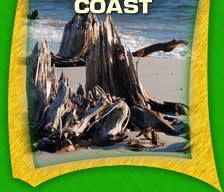|
Keep these fun facts and tips handy for when
you visit Florida's Forgotten Coast:
- A slice of paradise! In 1971, amazed by the area’s natural beauty, a local resident wrote a book proclaiming Apalachicola’s Bluffs and Ravines region the site of the biblical Garden of Eden.
- Blue crabs migrate as much as 300 miles to spawn in Apalachicola Bay.
- Before St. Vincent Island became a national wildlife refuge, it functioned as a private hunting reserve. At the time, exotic species like zebra and eland roamed wild and free. As years passed these large game animals died out, with the exception of the sambar deer, which can still be found on St. Vincent today. Native to Southeast Asia, this relative of the elk can weigh up to 700 pounds.
- The Apalachicola River serves as the boundary for the Eastern and Central time zones within the United States.
- Visitors to Apalachicola National Forest can observe one of the state’s most abundant plant communities, flatwoods. Before the1900’s flatwoods covered nearly half the state.
- The name Apalachicola is a combination of the Indian words apalachi and okli, meaning “on the other side” and “people.” According to Hitchiti natives, this phrase refers to “people on the other side of the river.”
- The ultimate beach bum is small, furry and lives life on the edge. The Choctawhatchee Beach Mouse digs burrows in coastal sand dunes located in Florida’s Walton and Bay Counties. Urban development and predation by introduced animals, such as the domestic house cat, have drastically reduced its numbers. In an effort to ensure species survival, environmentalists and developers have joined forces to reintroduce mice to areas where populations once existed.
- The Apalachicola River is home to the largest strand of tupelo trees in the world. These trees grow in remote swamps along the river, and are very difficult to access. Bees use this plant to produce a high quality, light colored honey which is collected during a short time in the spring.
Resources for this article
have been provided by the FWC, the Nature Conservancy, the Florida Department of Environmental Protection, and the U.S. Fish & Wildlife Service .
|





